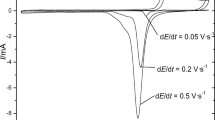Abstract
The dark conductivity of phthalocyanine thin-films are often sensitive to the presence of oxidising gases such that changes in conductivity magnitude are accompanied by shifts in the associated thermal activation energy for conduction. It is noted that the conductivity pre-factor and activation energy are invariably related by the Meyer-Neldel rule so that the conductivity becomes independent of the oxidising gas concentration at a finite temperature T 0. Data illustrating such a relationship are presented for evaporated metal-free phthtalocyanine films containing various amounts of absorbed oxygen where T 0 is estimated to be about 1161 K. Independent work has proposed that T 0 may be related to the energetic width of localised band tail states that are exponentially distributed and it is therefore argued that the T 0 magnitude for a particular phthalocyanine will dictate its potential application as a gas-sensing medium. Phthalocyanines that exhibit a low T 0 may thus offer low threshold detection possibilities at the expense of response speed, whereas high T 0 materials should be considered for situations demanding the rapid detection of high concentrations of oxidising gases.
Similar content being viewed by others
References
J. SIMON and J. J. ANDRE, in “Molecular Semiconductors” (Springer, Berlin, 1985).
P. M. BORSENBERGER and D. WEISS, in “Photoreceptors for Imaging Systems” (Marcel Decker, New York, 1993).
B. BOTT and S. C. THORPE, in “Techniques and Mechanisms in Gas Sensing,” edited by P. Moseley, J. Norris and D. Williams (Adam Hilger, New York, 1991) ch. 5.
H. TADA, H. TOUDA, H. TAKADA and K. MATSUSHIGE, Appl. Phys. Lett. 75 (2000) 873.
M. PASSARD, C. MALEYSSON, A. PAULY, S. DOGO, J. P. GERMAIN and J. P. BLANC, Sens. and Actuators B 18/19 (1994) 489.
Y. SADAOKA, Y. SAKAI, T. A. JONES and W. GOPEL, J. Mater. Sci. 25 (1990) 3024.
W. MEYER, Z Techn. Phys. 12 (1937) 588.
Y. F. CHEN and S. F. HUANG, Phys. Rev. B 44 (1991) 13775.
H. NAITO, K. KISHIMOTO and T. NAGASE, Thin Solid Films 331 (1998) 82.
Q. ZHOU and R. D. GOULD, ibid. 317 (1998) 432.
M. SILVER, L. PAUTMEIER and H. BASSLER, Solid State Comm. 72 (1989) 177.
Author information
Authors and Affiliations
Rights and permissions
About this article
Cite this article
Goldie, D.M. The implication of Meyer-Neldel behaviour for oxidising gas detection in phthalocyanine thin-films. Journal of Materials Science 37, 3323–3326 (2002). https://doi.org/10.1023/A:1016103605250
Issue Date:
DOI: https://doi.org/10.1023/A:1016103605250




